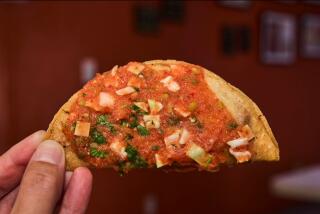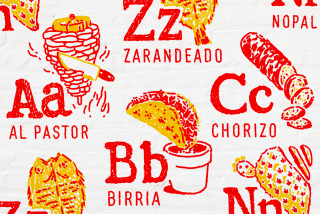The Story of a Frozen Tamale
Tamales are known in various regions as humitas, hallacas, ducanu, guanimas, guineo, paches and nacatamal. Their flavors vary as widely as their names. Oaxacaâs famous blue corn tamales rival a Chiapas specialty filled with iguana meat and eggs. Inland Guatemalans make tamales negros with a filling of chicken, prunes, olives and chocolate sauce. On the Caribbean side of Guatemala, around Livingston, people favor a tamal stuffed with shredded green banana, coconut milk and pork.
In some regions tamales are the length of your thumb; in others they can be 2 feet long. Even among home cooks of a single region, tamales vary as much as recipes for a Grandmaâs chicken soup.
âBasically, tamal-making is a personal art; everyoneâs grandmother or auntie has a style the family swears is best,â says Wray Morehouse Jr., partner in Tamales De Oro. Despite this, the company, which is based in Burbank, manufactures specialty Cuban tamales, individually packed in microwaveable Mylar pouches and sold frozen. Well, no matter how good her tamales are, grandmother isnât always there.
âWe noticed the paucity of good frozen Cuban-style tamales, and people have no time to cook their own,â Morehouse says. âIt was a sign of the times.â
Like all Cuban tamales, Tamales De Oro have no central stuffing. In effect theyâre a log-shaped steamed polenta speckled with bits of cured meat, cheese or vegetables.
But these are not quite traditional Cuban tamales, either. The company based its original formulation on a recipe from Dora and Pepe Riego, a San Fernando Valley Cuban couple who gained a huge following for their tamales made with corn oil in place of lard. They loved tamales but wanted to reduce the saturated fat they got from traditional lard-based versions.
âPeople loved them because they had a souffle-like quality,â Morehouse says. The tamales sold to people like the Riegos themselves--a working couple who had fled Cubaâs revolution. The story of their product typifies the journey of a recipe from home kitchen to large-scale automated tamale factory, including the expected pitfalls along the way.
Although conventionally packaged for supermarket consumption with nutrition information and bilingual instructions for steaming and microwaving on the box, in some ways the tamales are still in the experimental stage. Morehouse believes that theyâre not fluffy enough--theyâre rather flat in shape. âWeâre testing three-sided pouches now so the tamales will come out more log-shaped,â he says.
At any rate, Tamales De Oro are delicious, freckled with smoky bits of lean cured pork suspended in masa that has a pudding-like texture. These tamales have traveled a long way from the heavy corn-dough of their Aztec ancestors.
Next time youâre in a well-stocked Latin market, check out the frozen tamale section. There, among the Mexican and Cuban tamales and even tamales imported from El Salvador, are oil-based Tamales De Oro that got their start in the San Fernando Valley. They can be found at the following stores:
* Food Bag, a.k.a. El Cubano, 11350 Victory Blvd., North Hollywood, (818) 506-0911.
* Liborio Markets, 864 S. Vermont, Los Angeles (213) 386-1458. And 6061 Atlantic Blvd., Maywood, (213) 560-8000.
* Spectorâs, 2407 Victory Blvd. Burbank, (818) 841-0132 and (818) 841-0151.


